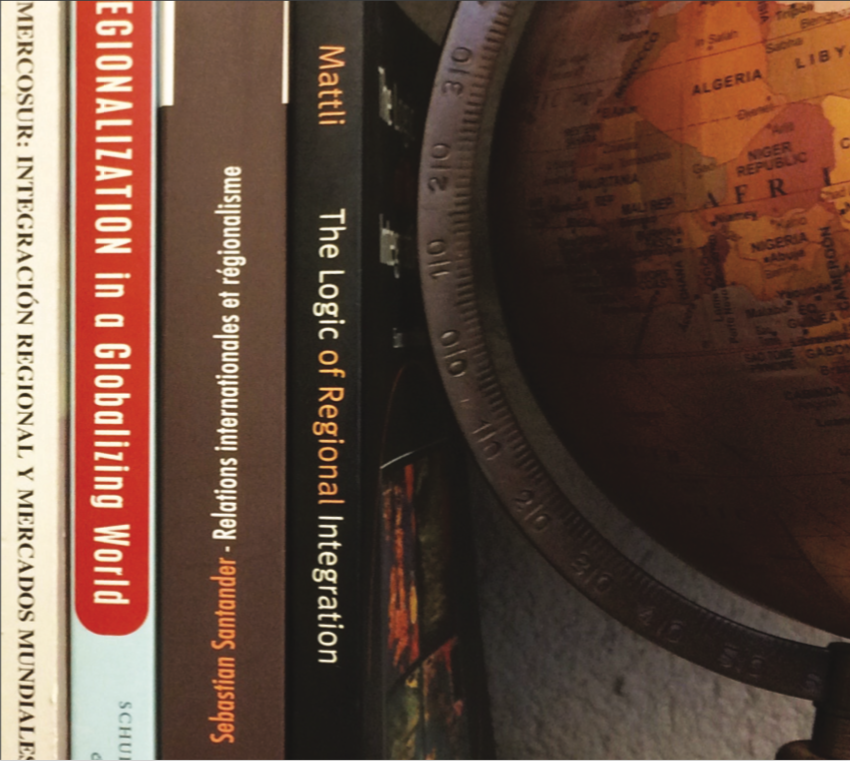- Accueil
- 2/2021 - Special issue Western Balkans, European U...
- Commercial Realism and EU Trade Policy: Competing for Economic Power in Asia and the Americas, by Katharina L. Meissner, London, Routledge, 2018, 215p. (ISBN: 9780367666484)
Visualisation(s): 730 (19 ULiège)
Téléchargement(s): 0 (0 ULiège)
Commercial Realism and EU Trade Policy: Competing for Economic Power in Asia and the Americas, by Katharina L. Meissner, London, Routledge, 2018, 215p. (ISBN: 9780367666484)

Table des matières
1This book seeks to understand the external trade relations of the European Union (EU), by challenging the liberal-institutionalist approach, which is dominant in the literature on EU foreign relations. Thus, the book explores why and how the EU systematically engages in trade relations and it analyzes the motives regarding the varying modes – bilateralism, interregionalism, multilateralism – of EU trade diplomacy. More specifically, the author emphasizes two key questions: firstly, she focuses on why the EU has turned from interregional to bilateral modes of external trade relations and secondly on why the EU restricts some of its relations to specific issues, while other external trade relations are comprehensive, by targeting investments, services, and regulatory standards. In order to develop a relevant answer to these questions, Katharina L. Meisner presents an approach drawing largely on core features of realist thought and calling it ‘commercial realism’. As such, she aims to develop a consistent theoretical framework, challenging competing theories on EU external relations rooted in liberal-institutionalist international relations theorizing, such as commercial liberalism (Moravscik, 1997; Dür, 2010; Meunier and Vachudova, 2018) and the principal-agent approach (Pollack, 2003; Da Conceiçao-Heldt, 2010; Andriaensen, 2016).
2The issue of whether internal/domestic or external factors linked to the international system shape an actor’s foreign policy is among the most stimulating topics in the international relations literature. Against a set of EU internal factors that are lobbying activities by European interest groups and the heterogeneity or homogeneity of EU member states’ preferences, commercial realism points out that these factors are not the only possible explanation of EU external trade action, paying special attention to factors located at the international level. K.L. Meisner assumes that external factors have a key impact on the modes of EU trade relations. She argues that the EU reacts to changes in the global economy when making decisions about its foreign trade relations. As stressed by the author, “the different modes the EU applies in external trade relations are a result of Europe’s attempt to secure its economic and regulatory power” (Meisner, 2018, p. 7) and they are strongly rooted both in the practices of rival actors such as the United States (US) and China in other world regions and in the varying degrees of cohesion of these regions. In this view, the EU seeks to promote an interregional mode of trade relations, when a region is highly cohesive, whereas a bilateral agreement is more likely to be successful with a region with less team spirit. Likewise, if the US and China have broad trade relations with a region that is cohesive, the EU is expected to promote a comprehensive interregionalism.
3The book’s research design is articulated around five cases. Main cases are drawn from the regions of Southeast Asia and South America, focusing on EU external trade relations towards Association of Southeast Asian Nations (ASEAN) and Southern Common Market (MERCOSUR). Secondary cases deal with the regions of Africa, Latin America and the Middle East, analysing the EU trade relations with the Southern African Development Community (SADC), the Andean Community (CAN) and the Gulf Cooperation Council (GCC). As such, the author argues that rival actors – the US and more recently China – had a strong impact on EU external trade relations and their modes towards Latin America. The EU promoted broad trade relations with MERCOSUR in order to secure its regulatory and economic powers vis-à-vis rival actors. However, the EU started to negotiate interregional agreements, and then switched to bilateral negotiations with Brazil, because MERCOSUR’s low cohesion was influential regarding the EU’s decision to choose a bilateral mode in exercising its trade relations. Moreover, according to the author, Europe’s turn from interregional to bilateral negotiations on comprehensive free trade agreements (FTAs) with CAN’s member states Colombia, Ecuador and Peru also confirms that the trade action of the US and China and the cohesion of a regional organisation have a key impact on the design of EU external trade relations and the EU’s use of bilateralism. In addition, K.L. Meissner argues that the rivaling activities of China and the US, as well as of Japan in combination with the breakdown of the World Trade Organization’s (WTO) Doha Round made negotiations on a comprehensive FTA with ASEAN’s economies an EU priority. However, the author suggests that the EU opted for bilateral agreements, such as those with Singapore or Vietnam deviating from its commitment to interregionalism, because the EU regional comprehensive ambition would clash with ASEAN’s lack of cohesion.
4Taken as a whole, the book succeeds in providing an integral and convincing analysis on why the EU has increasingly made use of bilateral trade relations, despite a normative commitment to support regional integration beyond Europe. The author develops a theoretical model based on commercial realism and it offers a parsimonious and relevant approach on EU external trade relations. Instead, three key points should receive more attention from the author.
5Firstly, K.L. Meissner considers the EU trade partners as passive actors, without concrete influence, trade agendas and specific interests. Instead, their role is to be subject to the international competition between strong trade powerhouses such as the US, the EU and China. However, the trade agreement between EU and MERCOSUR concluded in June 2019 reveals that the EU external trade relations are not only rooted in European internal factors or external ones located at the international level, but they are also strongly linked to the agenda of trade partners. A key reason for the conclusion of EU-MERCOSUR agreement after twenty years of negotiation is the convergence of trade interests from the two powerful economies of the organisation. In this respect, the arrival in power of Macri and Bolsonaro in Argentina and Brazil respectively made the EU-MERCOSUR interregional agreement an economic priority. Likewise, the bilateral trade agreement between EU and Singapore is also rooted in the ambitious trade agenda promoted by Singapore over the last twenty years and comprising in total 25 regional and bilateral FTAs.
6Secondly, the author considers bilateralism and interregionalism as conflictual EU trade practices, pitting these activities off against each other. In other words, when the EU opts for the bilateral way, it puts in question its interregional commitment. However, bilateralism and interregionalism could be complementary activities in the EU toolbox. In this respect, it would be interesting to explore if the EU started negotiating a trade agreement with Brazil in order to exert more pressure on the other MERCOSUR members and to use a potential bilateral agreement as a driver for an interregional partnership. In a similar vein, today the EU is negotiating trade agreements with ASEAN’s member states, while at the regional level, the European Commission and the ASEAN’s members are exploring the prospects towards the resumption of region-to-region negotiations through a joint EU-ASEAN Working Group.
7Thirdly, in 1997, regarding Andrew Moravcsik’s approach on liberal intergovernmentalism, Andy Smith and Christian Lequesne argued that “due to excessive rationalization, this theoretical enterprise is limited to be monocausal and therefore it only partially understands the originality of politics within the European Union” (Lequesne and Smith, 1997). As such, even though a parsimonious approach provides scientific rigor, it presents analytical limits in order to explore the complexity of the EU trade policy and the interlinked factors shaping the design of EU external relations. Thus, a multidimensional analysis, which finely balances internal and external factors is necessary for assessing the way the EU goes in asserting its trade powers in foreign affairs (Santander and Vlassis, 2020). For example, following a strong controversy about the powers and role of national and sub-national parliaments in the process of the EU-Canada Comprehensive Economic and Trade Agreement (CETA), the EU recently considered addressing investment provisions in separate agreements with EU partners. Put differently, an internal institutional factor had a clear impact on the design of EU external trade relations. Likewise, today the reinforcement of Eurosceptic parties in the European Parliament and of political groups reluctant to and critical about the promotion of trade agreements could shake up the design of the EU’s trade agenda. It is revealing that in the conclusion, the author acknowledges the importance of a complementary multi-causal approach, combining EU-external and EU-internal factors, in order to analyse “how rival actors, the counterpart region, EU member states, and interest groups operate together in explaining trade decisions” (Meissner, 2018, p. 207).
8To conclude, the book expands existing scholarship and opens up a much-needed conversation with respect to the factors shaping EU foreign policy and to the deep mutations underway in the EU external trade relations. There is no doubt that the book is a solid piece of work and can be recommended as key reading for scholars, researchers and practitioners in various areas, such as foreign policy, regionalism, international political economy, as well as EU external action.
References
9Books
10Andriaensen Johan (2016), National administrations in EU Trade Policy: Maintaining the capacity to control, London: Palgrave Macmillan.
11Dür Andreas (2010), Protection for Exporters: Power and Discrimination in Transatlantic Trade Relations, 1930-2010, Ithaca: Cornell University Press.
12Meissner Katharina L. (2018), Commercial Realism and EU Trade Policy: Competing for Economic Power in Asia and the Americas, London: Routledge.
13Pollack Mark A. (2003), The Engines of European Integration: Delegation, Agency and Agenda Setting in the EU, New York: Oxford University Press.
14Articles of scientific journals
15Da Conceiçao-Heldt Eugenia (2010), “Who controls whom? Dynamics of Power Delegation and Agency Loss in EU Trade Politics”, JCMS: Journal of Common Market Studies, 48(4), pp. 1107-1126.
16Lequesne Christian, Smith Andy (1997), “Union européenne et science politique : on en est le débat théorique ?”, Cultures & Conflits, 28 (online).
17Meunier Sophie, Vachudova Milada Anna (2018), “Liberal intergovernmentalism, illiberalism and the potential superpower of the European Union”, JCMS: Journal of Common Market Studies, 56(7), pp. 1631-1647.
18Moravscik Andrew (1997), “Taking Preferences Seriously: A Liberal Theory of International Politics”, International Organization, 51(4), pp. 513-553.
19Santander Sebastian, Vlassis Antonios (2020), “EU in Global Affairs: Constrained Ambition in an Unpredictable World?”, European Foreign Affairs Review, 25(1), pp. 5-22.
Pour citer cet article
A propos de : Antonios Vlassis
Antonios Vlassis is a senior researcher at the Center for Internatonal Relations Studies (CEFIR), lecturer at the Department of Political Science, University of Liège (ULiège) (Belgium) and editor-in-chief of the Journal of Cross-Regional Dialogues (JCRD)/Revue de Dialogues Inter-Régionaux (RDIR).






